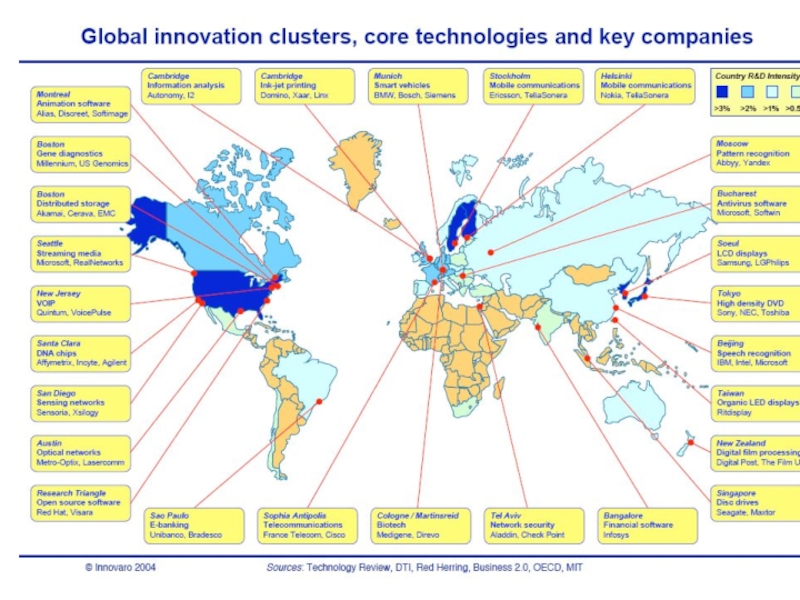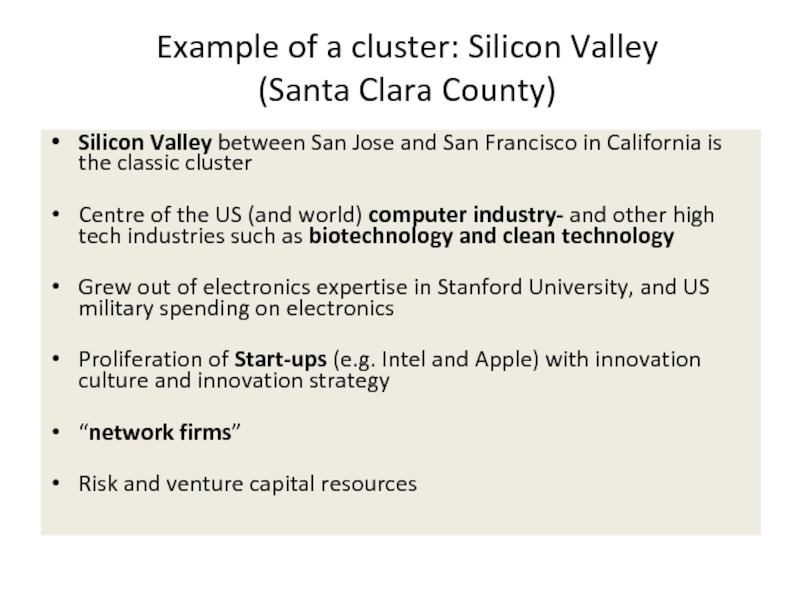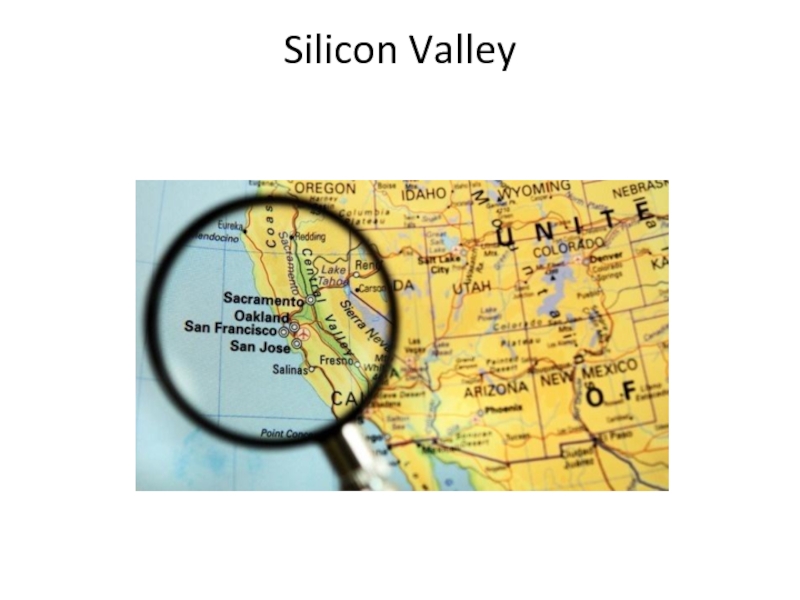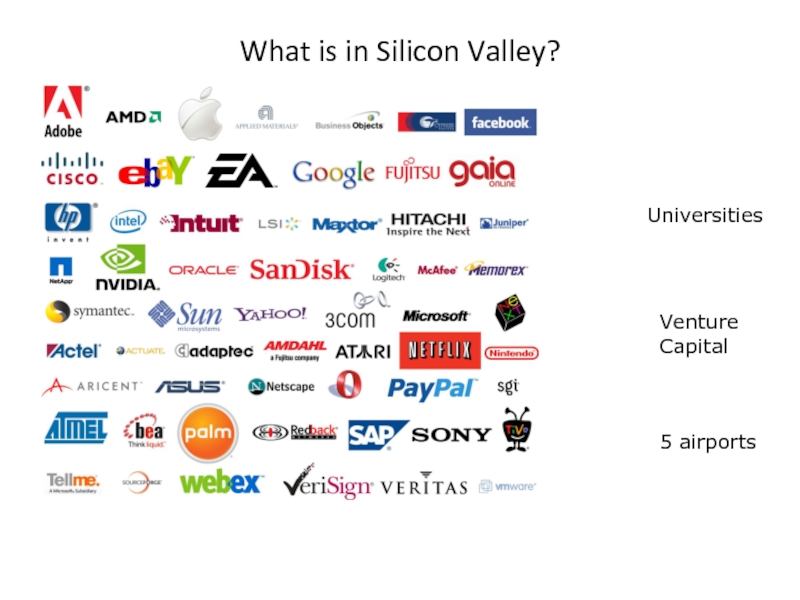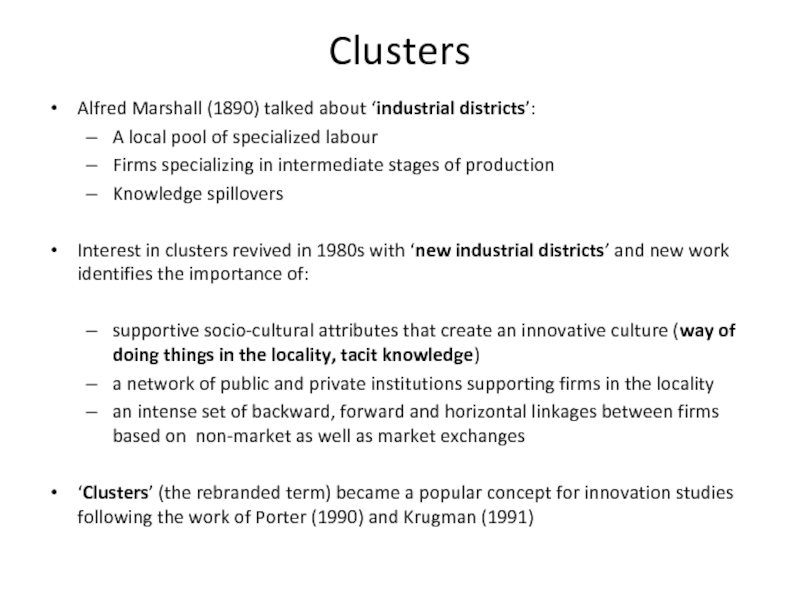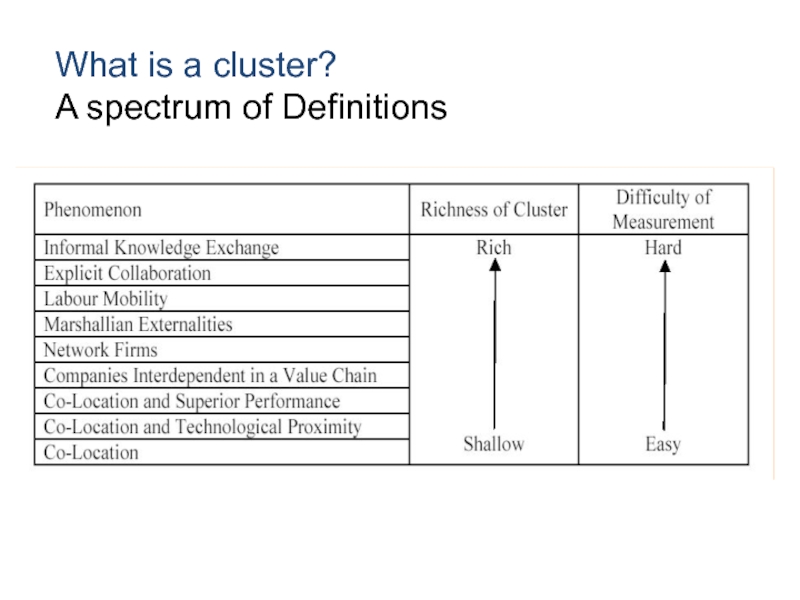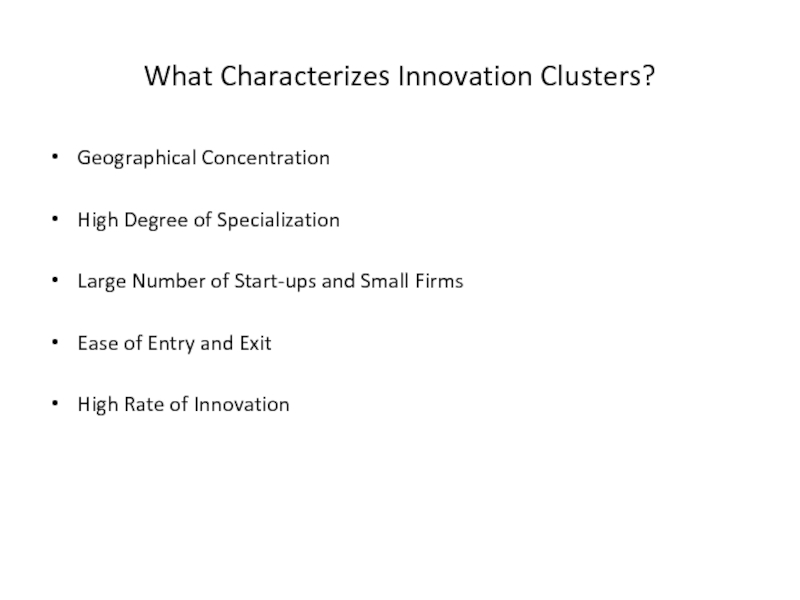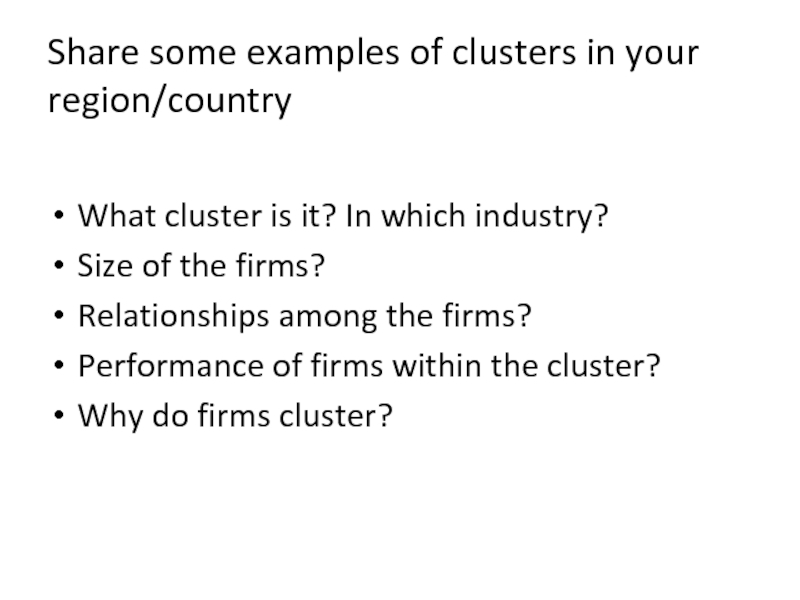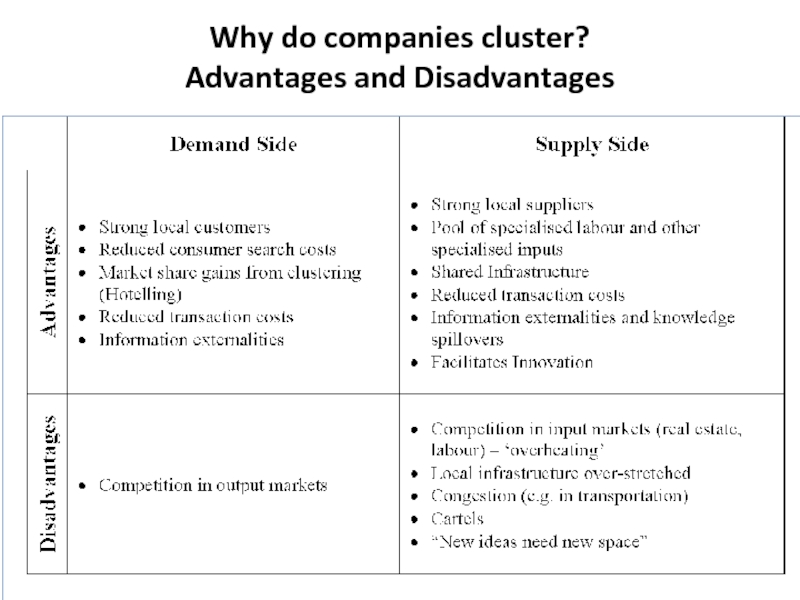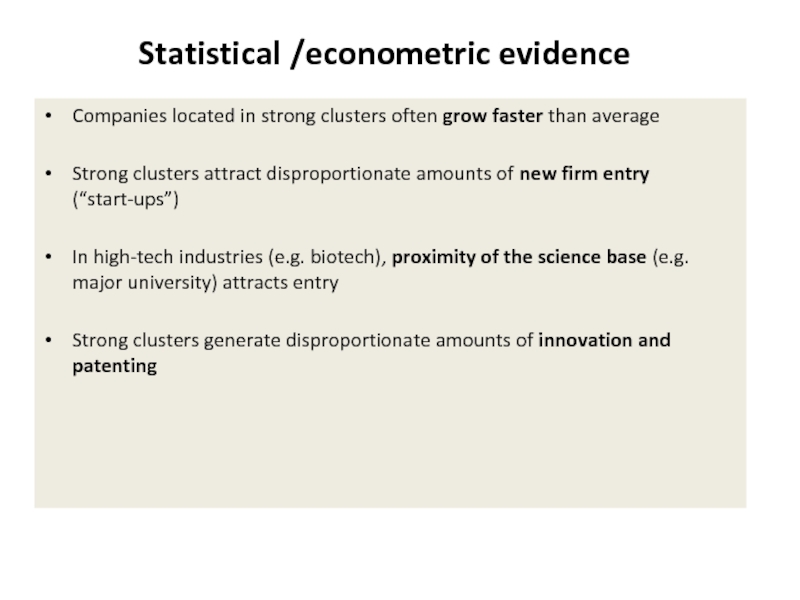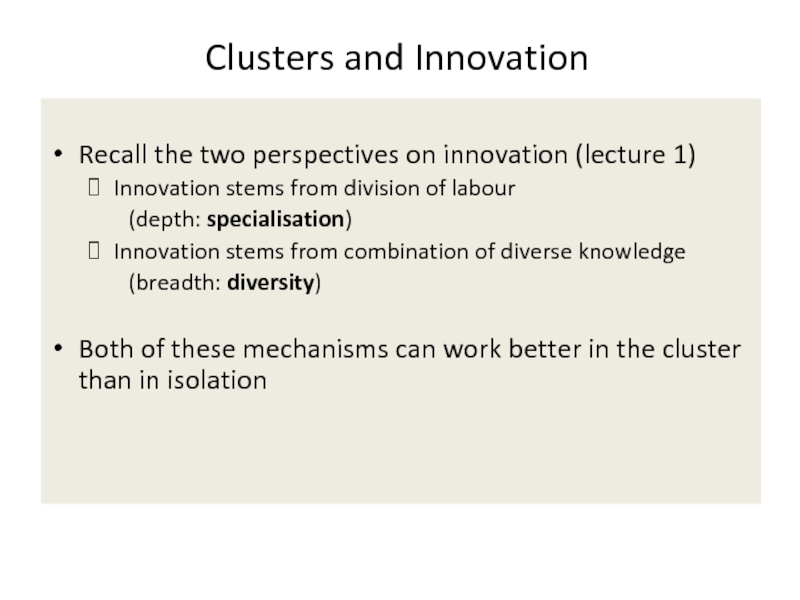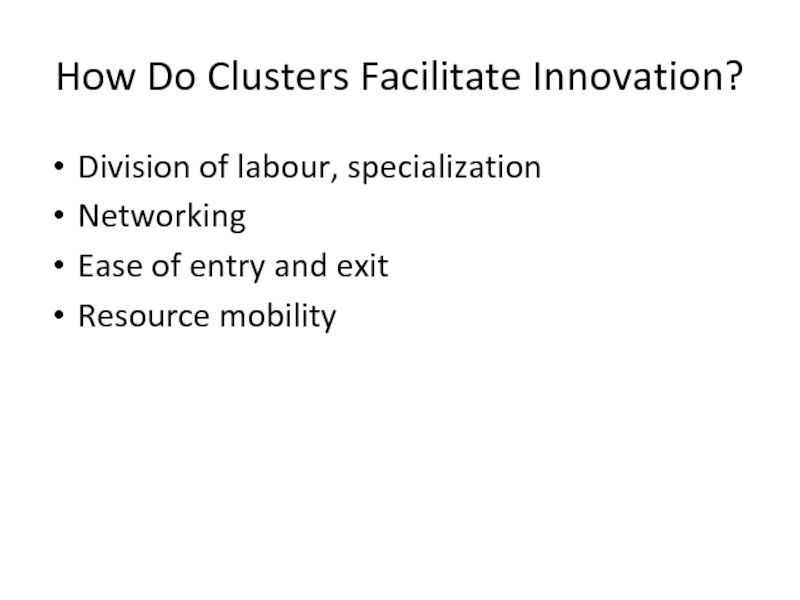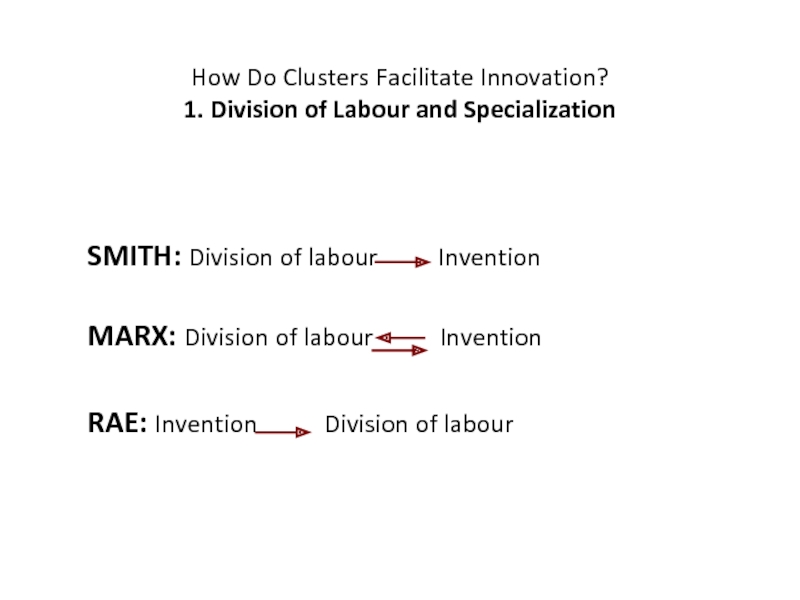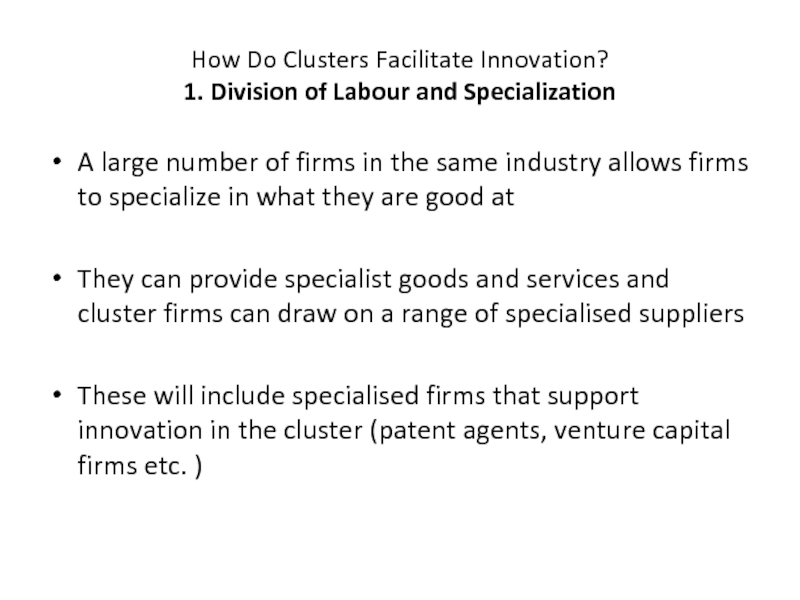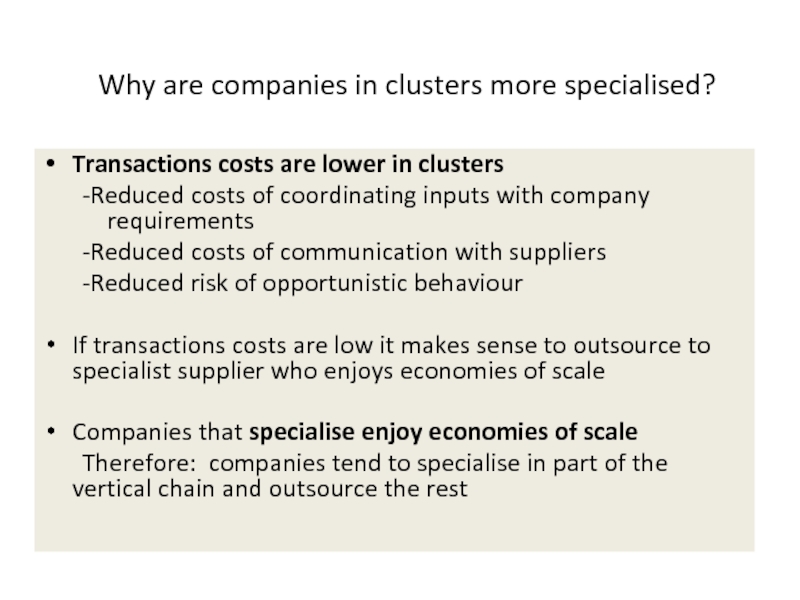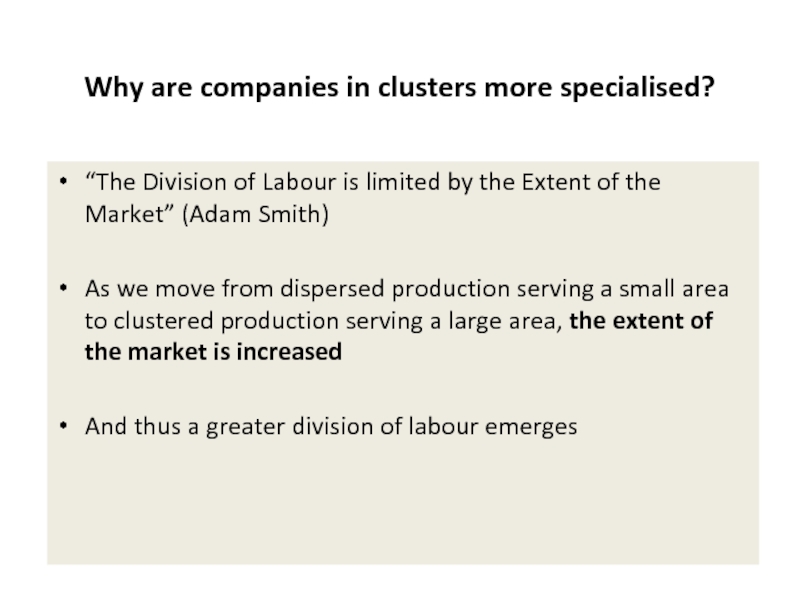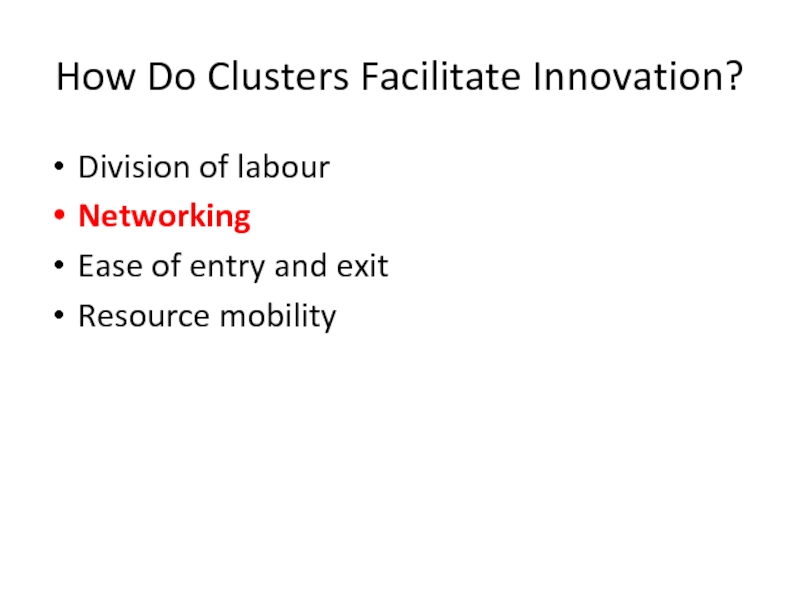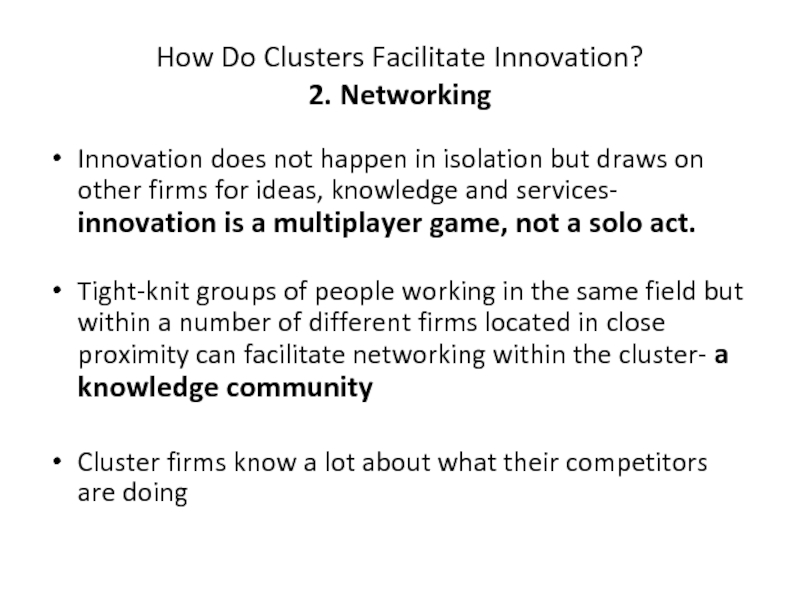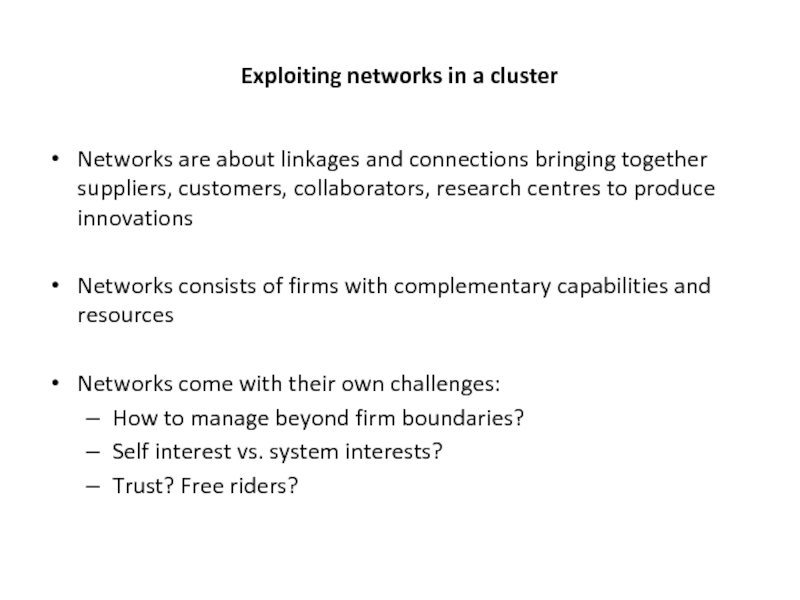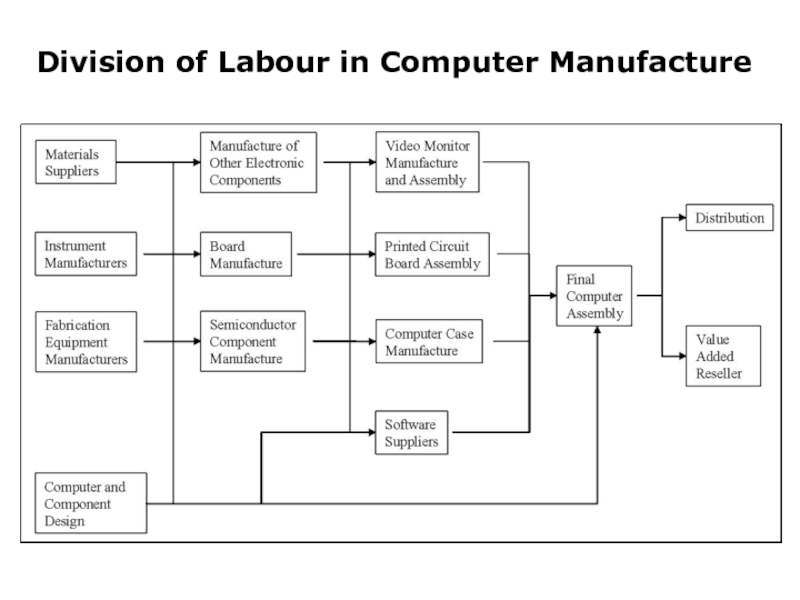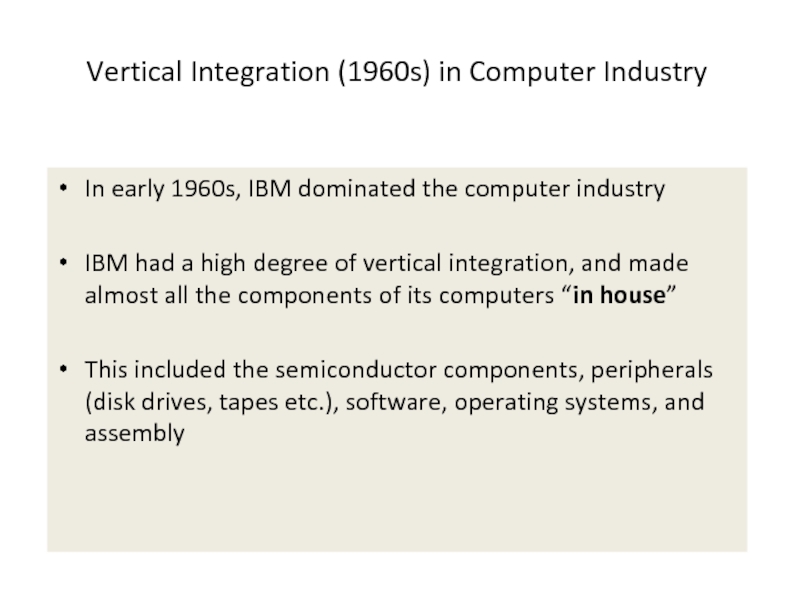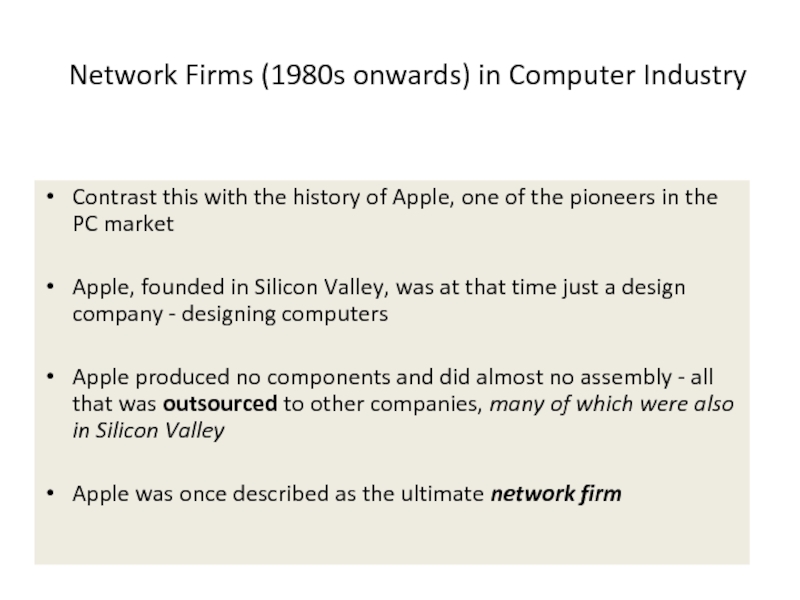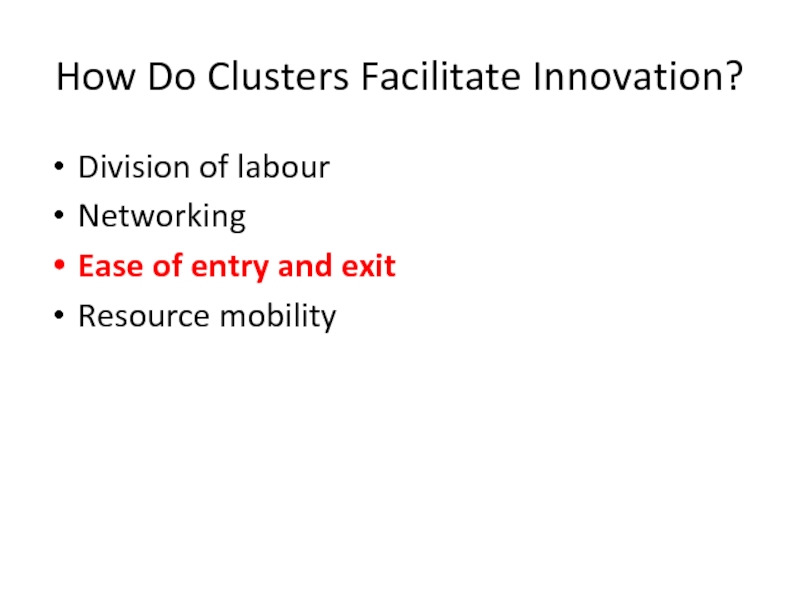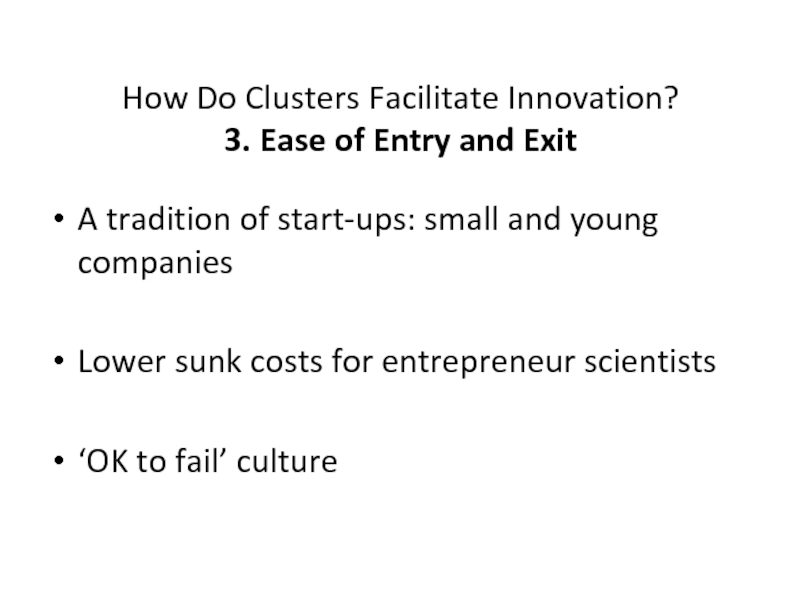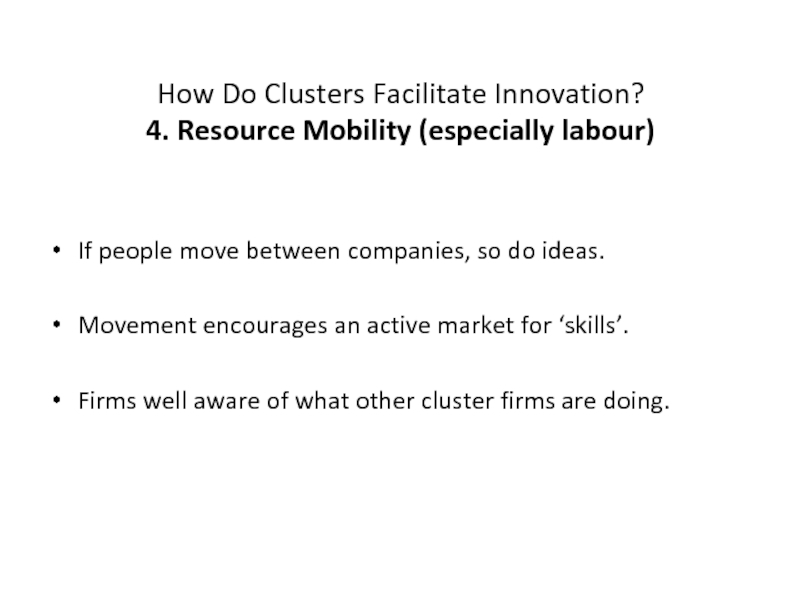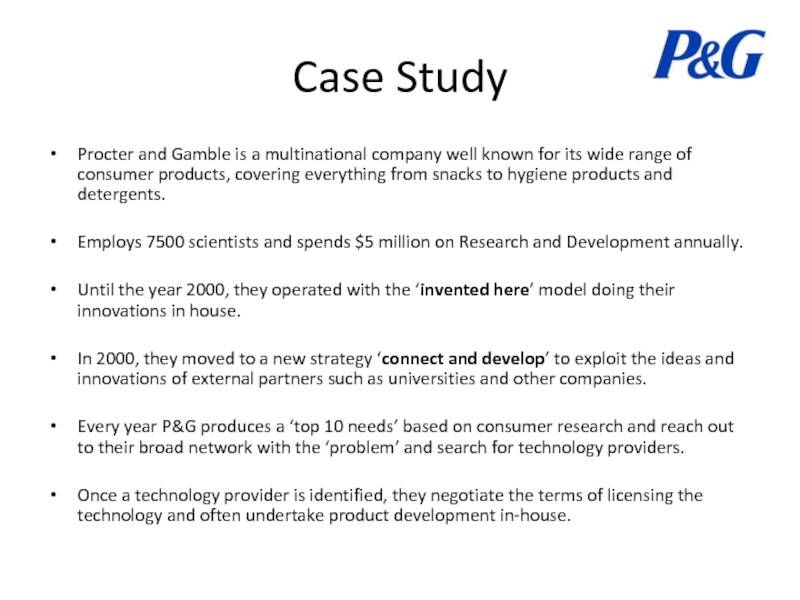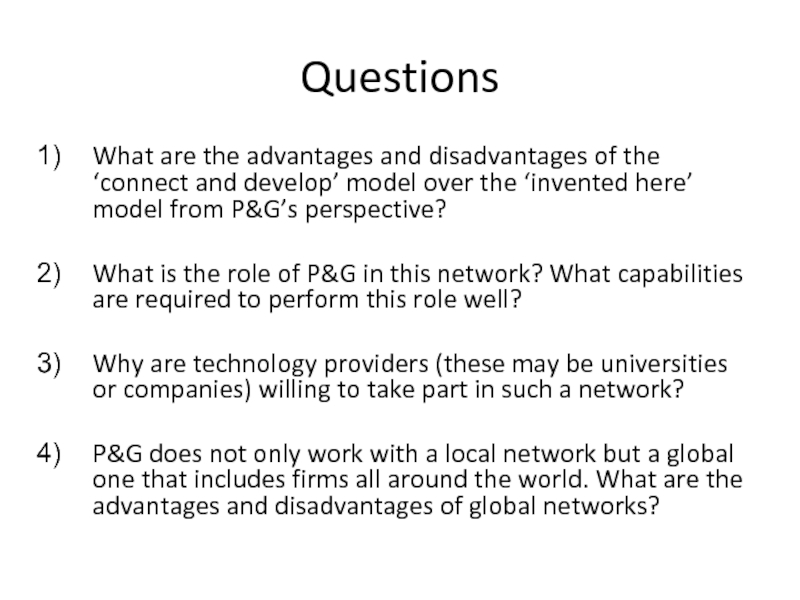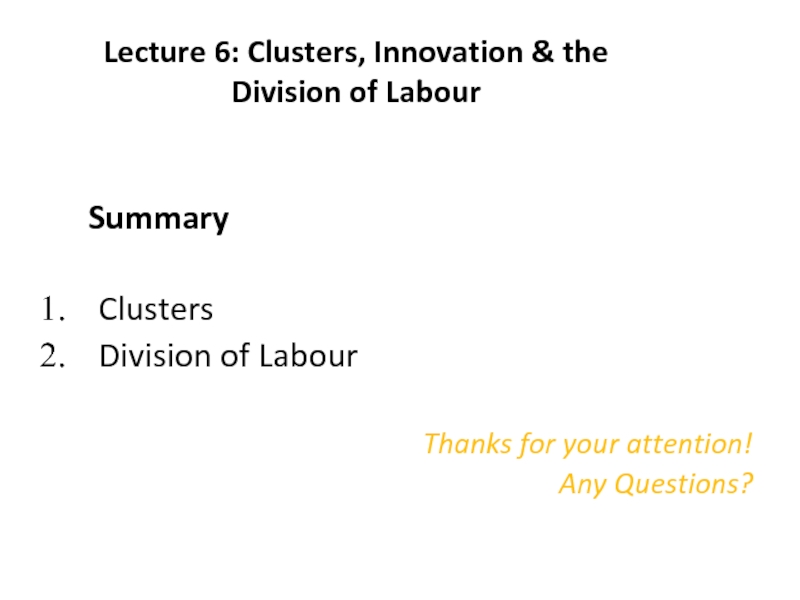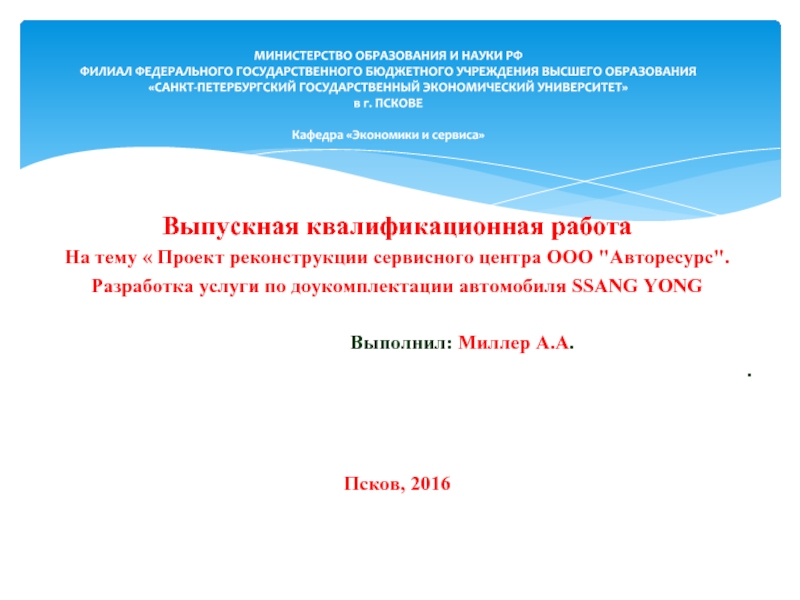- Главная
- Разное
- Дизайн
- Бизнес и предпринимательство
- Аналитика
- Образование
- Развлечения
- Красота и здоровье
- Финансы
- Государство
- Путешествия
- Спорт
- Недвижимость
- Армия
- Графика
- Культурология
- Еда и кулинария
- Лингвистика
- Английский язык
- Астрономия
- Алгебра
- Биология
- География
- Детские презентации
- Информатика
- История
- Литература
- Маркетинг
- Математика
- Медицина
- Менеджмент
- Музыка
- МХК
- Немецкий язык
- ОБЖ
- Обществознание
- Окружающий мир
- Педагогика
- Русский язык
- Технология
- Физика
- Философия
- Химия
- Шаблоны, картинки для презентаций
- Экология
- Экономика
- Юриспруденция
Economics of innovation. Lecture 6: Clusters, Innovation & the Division of Labour презентация
Содержание
- 1. Economics of innovation. Lecture 6: Clusters, Innovation & the Division of Labour
- 3. Example of a cluster: Silicon Valley (Santa
- 4. Silicon Valley
- 5. What is in Silicon Valley? 5 airports Venture Capital Universities 5 airports
- 6. Clusters Alfred Marshall (1890) talked about ‘industrial
- 7. What is a cluster? A spectrum of Definitions
- 8. What Characterizes Innovation Clusters? Geographical Concentration
- 9. Share some examples of clusters in your
- 10. Why do companies cluster? Advantages and Disadvantages
- 11. Statistical /econometric evidence Companies located in strong
- 12. Clusters and Innovation Recall the two
- 13. How Do Clusters Facilitate Innovation? Division of
- 14. How Do Clusters Facilitate Innovation?
- 15. How Do Clusters Facilitate Innovation? 1.
- 16. Why are companies in clusters more specialised?
- 17. Why are companies in clusters more specialised?
- 18. How Do Clusters Facilitate Innovation? Division of
- 19. How Do Clusters Facilitate Innovation? 2.
- 20. Exploiting networks in a cluster Networks are
- 21. Division of Labour in Computer Manufacture
- 22. Vertical Integration (1960s) in Computer Industry In
- 23. Network Firms (1980s onwards) in Computer Industry
- 24. How Do Clusters Facilitate Innovation? Division of
- 25. How Do Clusters Facilitate Innovation? 3.
- 26. How Do Clusters Facilitate Innovation? 4.
- 27. Case Study Procter and Gamble is a
- 28. Questions What are the advantages and disadvantages
- 29. Lecture 6: Clusters, Innovation & the Division
Слайд 3Example of a cluster: Silicon Valley
(Santa Clara County)
Silicon Valley between San
Jose and San Francisco in California is the classic cluster
Centre of the US (and world) computer industry- and other high tech industries such as biotechnology and clean technology
Grew out of electronics expertise in Stanford University, and US military spending on electronics
Proliferation of Start-ups (e.g. Intel and Apple) with innovation culture and innovation strategy
“network firms”
Risk and venture capital resources
Centre of the US (and world) computer industry- and other high tech industries such as biotechnology and clean technology
Grew out of electronics expertise in Stanford University, and US military spending on electronics
Proliferation of Start-ups (e.g. Intel and Apple) with innovation culture and innovation strategy
“network firms”
Risk and venture capital resources
Слайд 6Clusters
Alfred Marshall (1890) talked about ‘industrial districts’:
A local pool of specialized
labour
Firms specializing in intermediate stages of production
Knowledge spillovers
Interest in clusters revived in 1980s with ‘new industrial districts’ and new work identifies the importance of:
supportive socio-cultural attributes that create an innovative culture (way of doing things in the locality, tacit knowledge)
a network of public and private institutions supporting firms in the locality
an intense set of backward, forward and horizontal linkages between firms based on non-market as well as market exchanges
‘Clusters’ (the rebranded term) became a popular concept for innovation studies following the work of Porter (1990) and Krugman (1991)
Firms specializing in intermediate stages of production
Knowledge spillovers
Interest in clusters revived in 1980s with ‘new industrial districts’ and new work identifies the importance of:
supportive socio-cultural attributes that create an innovative culture (way of doing things in the locality, tacit knowledge)
a network of public and private institutions supporting firms in the locality
an intense set of backward, forward and horizontal linkages between firms based on non-market as well as market exchanges
‘Clusters’ (the rebranded term) became a popular concept for innovation studies following the work of Porter (1990) and Krugman (1991)
Слайд 8What Characterizes Innovation Clusters?
Geographical Concentration
High Degree of Specialization
Large Number of
Start-ups and Small Firms
Ease of Entry and Exit
High Rate of Innovation
Ease of Entry and Exit
High Rate of Innovation
Слайд 9Share some examples of clusters in your region/country
What cluster is it?
In which industry?
Size of the firms?
Relationships among the firms?
Performance of firms within the cluster?
Why do firms cluster?
Size of the firms?
Relationships among the firms?
Performance of firms within the cluster?
Why do firms cluster?
Слайд 11Statistical /econometric evidence
Companies located in strong clusters often grow faster than
average
Strong clusters attract disproportionate amounts of new firm entry (“start-ups”)
In high-tech industries (e.g. biotech), proximity of the science base (e.g. major university) attracts entry
Strong clusters generate disproportionate amounts of innovation and patenting
Strong clusters attract disproportionate amounts of new firm entry (“start-ups”)
In high-tech industries (e.g. biotech), proximity of the science base (e.g. major university) attracts entry
Strong clusters generate disproportionate amounts of innovation and patenting
Слайд 12Clusters and Innovation
Recall the two perspectives on innovation (lecture 1)
Innovation stems
from division of labour
(depth: specialisation)
Innovation stems from combination of diverse knowledge
(breadth: diversity)
Both of these mechanisms can work better in the cluster than in isolation
(depth: specialisation)
Innovation stems from combination of diverse knowledge
(breadth: diversity)
Both of these mechanisms can work better in the cluster than in isolation
Слайд 13How Do Clusters Facilitate Innovation?
Division of labour, specialization
Networking
Ease of
entry and exit
Resource mobility
Resource mobility
Слайд 14
How Do Clusters Facilitate Innovation?
1. Division of Labour and Specialization
SMITH:
Division of labour Invention
MARX: Division of labour Invention
RAE: Invention Division of labour
MARX: Division of labour Invention
RAE: Invention Division of labour
Слайд 15How Do Clusters Facilitate Innovation?
1. Division of Labour and Specialization
A
large number of firms in the same industry allows firms to specialize in what they are good at
They can provide specialist goods and services and cluster firms can draw on a range of specialised suppliers
These will include specialised firms that support innovation in the cluster (patent agents, venture capital firms etc. )
They can provide specialist goods and services and cluster firms can draw on a range of specialised suppliers
These will include specialised firms that support innovation in the cluster (patent agents, venture capital firms etc. )
Слайд 16Why are companies in clusters more specialised?
Transactions costs are lower in
clusters
-Reduced costs of coordinating inputs with company requirements
-Reduced costs of communication with suppliers
-Reduced risk of opportunistic behaviour
If transactions costs are low it makes sense to outsource to specialist supplier who enjoys economies of scale
Companies that specialise enjoy economies of scale
Therefore: companies tend to specialise in part of the vertical chain and outsource the rest
-Reduced costs of coordinating inputs with company requirements
-Reduced costs of communication with suppliers
-Reduced risk of opportunistic behaviour
If transactions costs are low it makes sense to outsource to specialist supplier who enjoys economies of scale
Companies that specialise enjoy economies of scale
Therefore: companies tend to specialise in part of the vertical chain and outsource the rest
Слайд 17Why are companies in clusters more specialised?
“The Division of Labour is
limited by the Extent of the Market” (Adam Smith)
As we move from dispersed production serving a small area to clustered production serving a large area, the extent of the market is increased
And thus a greater division of labour emerges
As we move from dispersed production serving a small area to clustered production serving a large area, the extent of the market is increased
And thus a greater division of labour emerges
Слайд 18How Do Clusters Facilitate Innovation?
Division of labour
Networking
Ease of entry and
exit
Resource mobility
Resource mobility
Слайд 19How Do Clusters Facilitate Innovation?
2. Networking
Innovation does not happen in
isolation but draws on other firms for ideas, knowledge and services- innovation is a multiplayer game, not a solo act.
Tight-knit groups of people working in the same field but within a number of different firms located in close proximity can facilitate networking within the cluster- a knowledge community
Cluster firms know a lot about what their competitors are doing
Tight-knit groups of people working in the same field but within a number of different firms located in close proximity can facilitate networking within the cluster- a knowledge community
Cluster firms know a lot about what their competitors are doing
Слайд 20Exploiting networks in a cluster
Networks are about linkages and connections bringing
together suppliers, customers, collaborators, research centres to produce innovations
Networks consists of firms with complementary capabilities and resources
Networks come with their own challenges:
How to manage beyond firm boundaries?
Self interest vs. system interests?
Trust? Free riders?
Networks consists of firms with complementary capabilities and resources
Networks come with their own challenges:
How to manage beyond firm boundaries?
Self interest vs. system interests?
Trust? Free riders?
Слайд 22Vertical Integration (1960s) in Computer Industry
In early 1960s, IBM dominated the
computer industry
IBM had a high degree of vertical integration, and made almost all the components of its computers “in house”
This included the semiconductor components, peripherals (disk drives, tapes etc.), software, operating systems, and assembly
IBM had a high degree of vertical integration, and made almost all the components of its computers “in house”
This included the semiconductor components, peripherals (disk drives, tapes etc.), software, operating systems, and assembly
Слайд 23Network Firms (1980s onwards) in Computer Industry
Contrast this with the history
of Apple, one of the pioneers in the PC market
Apple, founded in Silicon Valley, was at that time just a design company - designing computers
Apple produced no components and did almost no assembly - all that was outsourced to other companies, many of which were also in Silicon Valley
Apple was once described as the ultimate network firm
Apple, founded in Silicon Valley, was at that time just a design company - designing computers
Apple produced no components and did almost no assembly - all that was outsourced to other companies, many of which were also in Silicon Valley
Apple was once described as the ultimate network firm
Слайд 24How Do Clusters Facilitate Innovation?
Division of labour
Networking
Ease of entry and
exit
Resource mobility
Resource mobility
Слайд 25How Do Clusters Facilitate Innovation?
3. Ease of Entry and Exit
A
tradition of start-ups: small and young companies
Lower sunk costs for entrepreneur scientists
‘OK to fail’ culture
Lower sunk costs for entrepreneur scientists
‘OK to fail’ culture
Слайд 26How Do Clusters Facilitate Innovation?
4. Resource Mobility (especially labour)
If people
move between companies, so do ideas.
Movement encourages an active market for ‘skills’.
Firms well aware of what other cluster firms are doing.
Movement encourages an active market for ‘skills’.
Firms well aware of what other cluster firms are doing.
Слайд 27Case Study
Procter and Gamble is a multinational company well known for
its wide range of consumer products, covering everything from snacks to hygiene products and detergents.
Employs 7500 scientists and spends $5 million on Research and Development annually.
Until the year 2000, they operated with the ‘invented here’ model doing their innovations in house.
In 2000, they moved to a new strategy ‘connect and develop’ to exploit the ideas and innovations of external partners such as universities and other companies.
Every year P&G produces a ‘top 10 needs’ based on consumer research and reach out to their broad network with the ‘problem’ and search for technology providers.
Once a technology provider is identified, they negotiate the terms of licensing the technology and often undertake product development in-house.
Employs 7500 scientists and spends $5 million on Research and Development annually.
Until the year 2000, they operated with the ‘invented here’ model doing their innovations in house.
In 2000, they moved to a new strategy ‘connect and develop’ to exploit the ideas and innovations of external partners such as universities and other companies.
Every year P&G produces a ‘top 10 needs’ based on consumer research and reach out to their broad network with the ‘problem’ and search for technology providers.
Once a technology provider is identified, they negotiate the terms of licensing the technology and often undertake product development in-house.
Слайд 28Questions
What are the advantages and disadvantages of the ‘connect and develop’
model over the ‘invented here’ model from P&G’s perspective?
What is the role of P&G in this network? What capabilities are required to perform this role well?
Why are technology providers (these may be universities or companies) willing to take part in such a network?
P&G does not only work with a local network but a global one that includes firms all around the world. What are the advantages and disadvantages of global networks?
What is the role of P&G in this network? What capabilities are required to perform this role well?
Why are technology providers (these may be universities or companies) willing to take part in such a network?
P&G does not only work with a local network but a global one that includes firms all around the world. What are the advantages and disadvantages of global networks?
Слайд 29Lecture 6: Clusters, Innovation & the Division of Labour
Summary
Clusters
Division of Labour
Thanks
for your attention!
Any Questions?
Any Questions?

